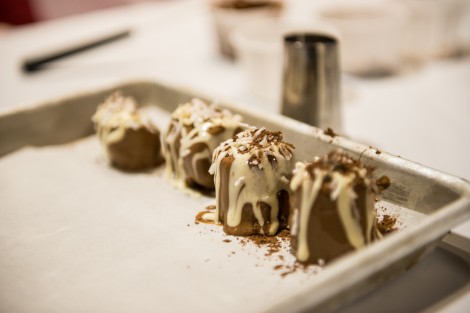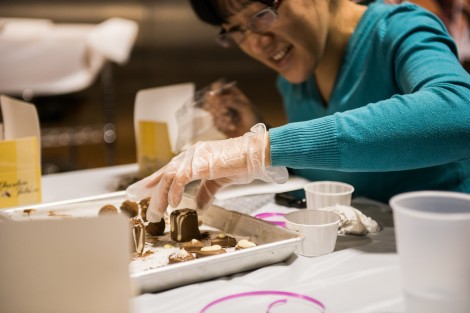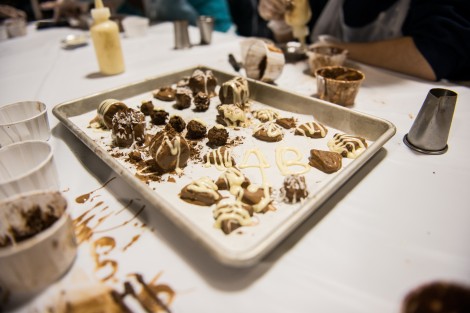As I entered the Market Kitchen that overlooks the large brick warehouse of St. Lawrence Market, I was hit by the scent of fresh, rich chocolate, quickly marred by the residual aromas of fish and day-old produce. The room was brimming with couples venturing on out-of-the-box dates, families on shopping excursions, and people scoping out the Chocolate Tales Workshop.
I do not possess the most sophisticated culinary palette. My skills as a foodie are limited to sometimes correctly identifying the difference between Coke and Pepsi. When it comes to chocolate, my connoisseurship is restricted to my ability to make it miraculously vanish by eating all of it, really fast. Accompanied by a history of kitchen mishaps ranging from burning every bag of popcorn I’ve ever made to using salt instead of sugar to bake cookies, I embarked upon the task of learning to make chocolate.
The Chocolate Tales Workshop is a hands-on introduction to chocolate making. My session was led by “Cocoa” (a.k.a. Kelly Maxfield), who began by providing a brief overview of the history of chocolate. As a history minor, this, I knew, was the one moment in this workshop where I would excel. I took careful notes, clinging to the hopeful delusion that we might be quizzed on the information later, and I would be able to prove my personal merit in light of the inevitable failure of my foray into the art of chocolate making.
The first use of chocolate occurred in Mexico approximately 2000 years ago by the Mayans, who ground cocoa beans into a fine powder and then placed them in boiling water. The result was essentially a bitter hot chocolate. Without milk or sugar to sweeten the drink, the Mayans instead added sweet corn or hot pepper to the beverage to add flavour. Chocolate was enjoyed almost exclusively by royalty, and only occasionally indulged in at celebrations of the common people. A king after my own heart consumed over fifty cups of this chocolate beverage per day. Chocolate was also given to Mayan prisoners subject to the death sentence immediately before their punishment, due to chocolate’s comforting qualities. Chocolate releases serotonin in the brain, which in turn makes us happy, or as Kelly put it, produces that “oolala-we-love-chocolate-feeling.”
The secret of producing this chocolate drink was brought to Europe by a Spanish explorer. In Spain, sugar was added to the beverage for the first time, after which chocolate began to spread throughout Europe. Chocolate was first produced in solid form in the 1800s, and it was the Swiss who began adding dried milk to chocolate, producing the creatively titled “milk chocolate.”
Chocolate is grown on cacao trees, which form pods that resemble footballs. Once ready, farmers open the harvested pods with machetes to reveal the white cocoa beans, which roast in the sun and achieve the familiar brown colour of chocolate. In a factory, the cocoa bean is processed in order to separate the cocoa powder and the cocoa butter.
Now sufficiently educated to open up our own cacao tree farms and chocolate factories, the group proceeded to get our hands on some chocolate. The workshop began with an exercise in developing our palettes, and we were each given three ganache tasters with different flavour profiles. The ganache was made from a high-grade chocolate with a high content of cocoa butter, mixed with whipping cream, causing it to be velvety and glossy.
A mild shot of ganache was spiced with cinnamon, a medium shot with ground ginger, and a bold shot with cajan pepper. I was certain that old reliable cinnamon would be my preference of the three. Much to my surprise, I found the cajan pepper ganache the most delicious due to its intense flavour. Side note: chocolate shooters should definitely be an alternative option at all bars.
We were then given tempered chocolate in which to dip marshmallows and ganache, along with different toppings for decorating our creations. Kelly explained how to shape our chocolates and create moulds to fill with milk chocolate, which I promptly failed to do, producing instead poorly decorated marshmallows, a bunch of triangular shaped chocolates, and lots of truffles because rolling chocolate into a ball was the only option within my creative capacity.’
Around the table, participants focused intensely on their decorating. Some even made an attempt at drawing swirling designs on their chocolates, while others glumly surveyed their sad clumps of white chocolate and coconut shavings.
Our final chocolate-making task was to employ our decidedly professional skills while garnishing miniature chocolate lava cakes with milk chocolate and cocoa powder. I enlisted the help of photo editor Bernarda Gospic in creating a checkerboard of milk chocolate, over which I delicately sprinkled cocoa powder. Miraculously, it didn’t look terrible, and I felt far more accomplished than I should have for finally producing something half-decent looking.
We wrapped up our chocolate creations in little plastic bags and tied ribbons around them. My stomach was aching from all the bits and pieces here and there I’d nibbled on over the course of the workshop, and the pages of my notebook were stained with chocolate fingerprints. I had overdosed on ganache.
I later brought the chocolates to a few friends to get their opinions, and the general consensus was that my work was, in fact, not bad at all. Given that review, and in light of my reputation as a disastrous chef, I consider my brief stint as a chocolatier-to-be, in modest terms, a downright triumph.







